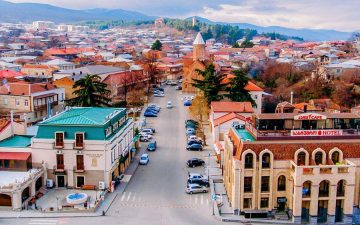Affordable car hire in Telavi with delivery to any location. Choose from a wide range of vehicles for your travel needs. Book easily and drive today
Car Hire in Telavi – Explore Georgia’s Wine Country on Your Terms
It started as a weekend idea. A friend mentioned this museum in a European-style palace in Telavi, some vineyard nearby, and said something about Pushkin visiting. Curious, we drove from Tbilisi. We didn’t expect much — but we ended up extending our stay. And you might, too.
Book Now From Car Hire in Telavi – Any Location
Attention! Business hours are optional for any location. We work 24 hours a day, 7 days a week, without weekends and holidays! Prices for Pick-Up and Return do not change depending on the time of day!
- Pick-Up: 40 USD
- Return: 40 USD
- Early Pick-Up: 40 USD
- Late Return: 40 USD
- Mondays: 00:00 - 23:59
- Tuesdays: 00:00 - 23:59
- Wednesdays: 00:00 - 23:59
- Thursdays: 08:00 - 20:00
- Fridays: 08:00 - 20:00
- Saturdays: 08:00 - 20:00
- Sundays: 08:00 - 20:30
What makes Telavi so special?
Telavi is the heart of the Kakheti region, known for its wine, culture, and beautiful countryside. It’s not just a stopover — it’s a destination. You’ll find cobbled streets, sleepy vineyards, 19th-century mansions, and locals who will talk your ear off about which grape is best for qvevri wine.
Do you need a car to visit Telavi?
In one word: Yes. Public transport exists, sure, but it doesn’t get you to the good places — like the Alexandre Chavchavadze Museum or the Shumi Winery. A car gives you freedom. Want to stop at a roadside stall to buy churchkhela? You can. Feel like taking the backroad through Tsinandali? Easy.
Car Rental Telavi – We Deliver Anywhere
When you book with us at carsandrooms.ge, we don’t just give you a pickup spot — we come to you. Whether you’re staying in a guesthouse in Telavi centre or at a vineyard retreat on the outskirts, we offer Rent a Car in Telavi – Any Place Delivery.
It’s what sets us apart from traditional agencies.
How it works
1. Choose your car
From compact models for town driving to SUVs for those rougher vineyard paths. Need something automatic? No problem. Want something with extra boot space for wine crates? We’ve got you.
2. Tell us where you are
We offer Telavi Car Hire – Anywhere You Need. That means we’ll drop the car off at your accommodation, meet you at a café, or even deliver to the Shumi Winery if you fancy heading straight to the tastings.
3. Drive your own adventure
Telavi isn’t just about landmarks. It’s about detours, small villages with one bakery, hills that open up to valleys full of vines, and spontaneous roadside barbecues. With your own vehicle, you set the pace. And trust us — there’s a lot you’ll want to stop and take in.
Don’t miss these spots
Alexandre Chavchavadze Museum
This European-style palace is rich in history. Alexandre wasn’t just a poet — he was a bridge between worlds. His home hosted the likes of Pushkin and Griboedov. Today, you can walk through his home, hear stories in your language (tours available in English, German, Russian, Georgian), and taste wine in the cellar where his factory once stood. It’s beautiful, peaceful, and a little bit eerie in the best way.
Shumi Winery
Just next door to the museum, this winery offers a relaxed experience. No pressure, just good wine and people happy to tell you about it. We didn’t plan on buying anything — we left with six bottles. It’s also where we learned that real Georgian wine doesn’t always make it to the shelves of big stores.

Helpful tips for your Telavi road trip
- Drive carefully: Country roads are narrow and winding. Locals know them well — you probably don’t.
- Parking: Generally easy, especially in Telavi town. Vineyards and museums have designated areas.
- Fuel: Stations are available, but not in every village. Keep your tank above half.
- Offline maps: Signal isn’t always strong. Download Google Maps areas in advance.
- Ask locals: Don’t be shy. Georgian hospitality is real, and locals often give the best directions.
Is it safe to drive in Telavi?
Yes — as long as you’re alert. Some drivers are fast, and road signage isn’t always perfect. But if you’re a confident driver and don’t rush, you’ll be fine. Plus, having your own car means you’re not tied to bus schedules or stuck waiting for a taxi in the middle of wine country.
Final thoughts from someone who’s done it
I wasn’t planning on writing this post. But after a weekend in Telavi, with a car that took us to places no tour could have, I felt like someone should know. Renting a car gave us the freedom to take wrong turns — and those turned out to be the best parts. If you’re heading to Telavi, do it your way. Go slow, talk to people, try the wine. And definitely, drive yourself.
Looking for Car Hire in Telavi? We’ve got you covered — check out our vehicles here and start your journey today.
Ready to Start Your Adventure?
Book your car rental at Ambrolauri Airport now and enjoy the freedom to explore Racha at your own pace.
Simple, fast, and with delivery right at the airport — no hassle, just the road ahead.
